Weare
|
1980
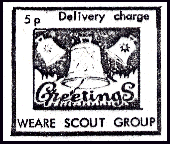
Proposed issue 60x45mm, designed and produced by N Handley (GSL) in sheets of 18 on A4 imperforate gummed paper. The production method was to stick parts of a Christmas sticker + typed strips of paper to make a sheet of 9 which was then copied to make a sheet 18 undated stamps. These were never issued but formed the basis for the 1981 dated issue whaich was reformatted into sheets of 12.
1981
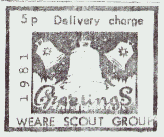
Type 1, 60x45mm, designed and produced by N Handley (GSL) in sheets of 12 on A4 imperforate gummed paper. There is considerable variation in details between the stamps on a sheet, to the extent that all are slightly different. A first day cover was produced.
1982

Type 2, 45x26mm (marginal copies often larger), designed and produced by N Handley (GSL) on sheets of 20 stamps (7 rows of 3 with the centre stamp replaced by a label) on gummed paper, line rouletted about 9 between stamps but margins imperf, also available imperforate. A first day cover was produced.
1983

Type 3, 45x30mm (marginal copies often larger), designed and produced by N Handley (GSL) on sheets of 20 stamps (7 rows of 3 with the centre stamp replaced by a label) on gummed paper, line rouletted about 9 between stamps but margins imperf. Completely imperforate sheets were also available, size A4, and were trimmed to the smaller size when perforated. A first day cover was produced.
1984
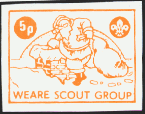

Types 4 to 5, 47x37mm & 33x37mm respectively (marginal copies often larger), designed and produced by N Handley (GSL) in sheets of 20 (5p - 7 rows of 3 with the centre stamp replaced by a label, 7p - 5 rows of 4) on imperforate sheets of gummed paper. A pair of first day covers were produced. The 2p surcharge was passed on to the Ethiopean Famine Appeal.
1985
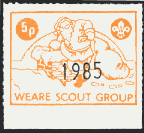
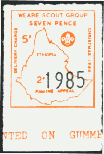
Types 6 to 7, 1984 issue overprinted with "1985" in black, 47x37mm & 33x37mm respectively (marginal copies often larger), designed and produced by N Handley (GSL) in sheets of 20 (5 rows of 4) on gummed paper, line rouletted about 9 between stamps but margins imperf. A pair of first day covers were produced. The 2p surcharge was passed on to Oxfam's Ethiopean Famine Appeal.
1986
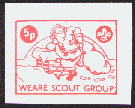
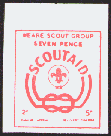
Types 8 to 9, 39x29mm & 34x36mm respectively, designed and produced by N Handley (GSL) in sheets of 20 (4 rows of 5) on gummed imperforate paper. A pair of first day covers were produced. The 2p surcharge was passed on to the Scoutaid Famine Appeal. Both designs were actually printed on a single A4 page before being separated into two.
1987

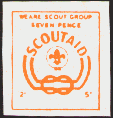
Types 10 to 11, 44x29mm & 34x36mm respectively, designed and produced by N Handley (GSL) on sheets of 20 (5p 7 rows of 3 with second space in top row blank - 7p 4 rows of 5) on gummed imperforate paper. A pair of first day covers were produced. The 2p surcharge was passed on to the Scoutaid Famine Appeal. Both designs were actually printed on a single A4 page before being separated into two.
1988
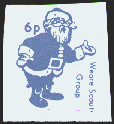
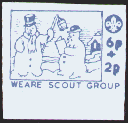
Types 12 to 13, 30x38mm & 42x30mm respectively, designed and produced by N Handley (GSL) in sheets of 20 (4 rows of 5) on gummed imperforate paper. A pair of first day covers were produced. The 2p surcharge was passed on to the Scoutaid Appeal. Both designs were actually printed on a single A4 page before being separated into two.
1989


Types 14 to 15, 28x25mm & 38x32mm respectively, designed and produced by N Handley (GSL) in sheets of 20 (4 rows of 5) on gummed imperforate paper. A pair of first day covers were produced. The 2p surcharge was passed on to a charity. Both designs were actually printed on a single A4 page before being separated into two.
1990


Types 16 to 17, 40x25mm & 58x28mm respectively, designed and produced by N Handley (GSL) in sheets of 20 or 10 (7p - 5 rows of 4, 9p - 4 rows of 3, labels in place of stamps 1 & 3 of row 3) on gummed imperforate paper. A pair of first day covers were produced. The 2p surcharge was passed on to Barnado's Homes. Both designs were actually printed on a single A4 page before being separated into two.
1991
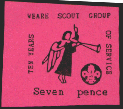
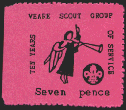
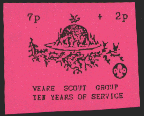
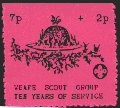
Types 18, 18a, 19 and 19a, 35x35mm & 35x37mm respectively, designed and produced by N Handley (GSL) in sheets of 20 (4 rows of 5) gummed imperforate paper. Types 18a & 19a received an experimental perforation. A pair of first day covers (only with imperf stamps) were produced. The 2p surcharge was passed on to Barnado's Homes. Both designs were actually printed on a single A4 page before being separated into two.
1992



Types 20, 21 & 21 a, 1990 issue overprinted in black or red, 40x25mm & 58x28mm respectively, designed and produced by N Handley (GSL) in sheets of 20 or 10 (7p - 5 rows of 4, 9p - 4 rows of 3, labels in place of stamps 1 & 3 of row 3) on gummed imperforate paper. A pair of first day covers were produced. The 2p surcharge was passed on to Croatia (the original inscription for Barnardo's Homes was amended in manuscript).
1993
No service.
1994

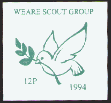
Types 22 to 23, 28x30mm & 30x30 respectively, designed and produced by N Handley (GSL) on sheets of gummed imperforate paper, as they were cut into singles by the printer no sheets exist. A pair of first day covers were produced. The 2p surcharge was passed on to a charity.
1995

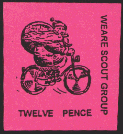
Types 24 to 25, 38x28mm & 35x38mm respectively, designed and produced by N Handley (GSL) in sheets of 15 (5 rows of 3 10p, 3 rows of 5 12p)gummed imperforate paper. A pair of first day covers were produced. The 2p surcharge was passed on to a charity.
1996

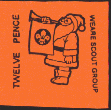
Types 26 to 27, 30x32mm & 32x32mm respectively, designed and produced by N Handley (Treasurer) on sheets of gummed imperforate paper. A pair of first day covers were produced. The 2p surcharge was passed on to a charity.
1997


Types 28 to 29, 25x28mm & 30x25mm respectively, designed and produced by N Handley (Treasurer) on sheets of gummed imperforate paper. A pair of first day covers were produced. The 2p surcharge was passed on to a charity.
1998

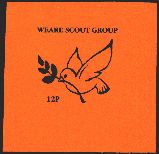
Types 30 to 31, 32x25mm & 32x30mm respectively, designed and produced by N Handley (Treasurer) on sheets of gummed imperforate paper. A pair of first day covers were produced. The 2p surcharge was passed on to a charity.
1999


Types 32 to 33, 30x30mm, designed and produced by N Handley (Treasurer) on sheets of adhesive labels. A pair of first day covers were produced. The 2p surcharge was passed on to a charity.
2000




Types 34, 34a, 35 & 35a, designed and produced by N Handley (Treasurer) on A4 sheets of 21 (7 rows of 3) 70x38mm self-adhesive labels, giving 42 stamps (7 rows of 3x10p & 3x12p), 2 per label. Design types 34/35 with narrower frames (28x34mm) appear as the left-hand of each pair, types 34a/35a with wider (30x34mm) frames appear as the right hand stamp of each pair. Sheets divided down the middle before distribution so no se-tenant pairs are available. Several trial prints were made on plain paper and were offered to collectors at a significant premium. A pair of first day covers were produced. The 2p surcharge was passed on to a charity.
2001






Types 36, 36a, 36b, 37, 37a & 37b, designed and produced by N Handley (Treasurer) on A4 sheets of 21 (7 rows of 3) 69x38mm self-adhesive labels, giving 42 stamps, 2 per label. Unlike 2000, designs produced on separate sheets. Design types 36/37 with narrower frames (28x34mm) appear as the left-hand of each pair, types 36a/37a with wider (30x34mm) frames appear as the right hand stamp of each pair, while the taller frames (30x36mm) of types 36b/37b appear once per sheet as the last design in row 5 (again the right-hand of a pair). The placing of the central design (candle & leaves / santa & parcels) is not always totally consistent - it can vary vertically by a small amount (outside the scope of a catalogue like this). A pair of first day covers were produced. The 2p surcharge was passed on to a charity.
2002

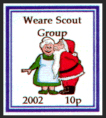
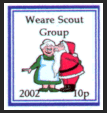
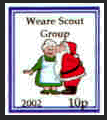


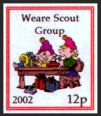
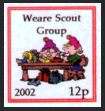
Types 38, 38a, 38b, 38c, 39, 39a, 39b & 39c, designed and produced by N Handley (Treasurer) on one of four types of self-adhesive label paper :-
(1) on A4 sheets of 21 (7 rows of 3) ??x38mm self-adhesive labels (produced by "Neat Ideas"), giving 36 stamps, 2 per label but with the fourth row blank;
(2) on A4 sheets of 21 (7 rows of 3) 64x38mm self-adhesive labels with rounded corners (produced by "Avery - type L1760"), giving 36 stamps, 2 per label but with the 4th row blank;
(3) on A4 sheets comprising 1 large label with no border (produced by Avery), subsequently hand cut into separate stamps (seen by compiler with both 10p & 12p stamps);
(4) on A4 sheets comprising 1 large label with a border (producer unknown - it has faint arrows on the back), subsequently hand cut into separate stamps, used copies from the left- and right-hand sheet edges will have part or all of the outer margin missing as the design overlapped the label edge. Only used for 10p stamps.
From the above it can be seen that a complete set of all design variations on all papers would comprise in excess of 20 stamps.
The sheet layout is the same regardless of paper type. Normal frame height 35mm. Design types 38/39/39a with narrower frames (28mm) appear as the left-hand of a pair, types 38a/38b/38c/39b/39c with wider (30mm) frames appear as the right hand stamp of a pair, while the shorter frames (33mm & 32mm) of types 36b/37c respectively appear once per sheet as the last design in the last row (again the right-hand of a pair). Type 38a has a slightly taller frame (35.5mm) and appears as the left hand of a pair with a normal type 39b. Type 38c has it's value in an oversized typeface and is a constant variety at row two stamp six. A pair of first day covers were produced. A single last day cover was also produced with a pair of each value. The 2p surcharge was passed on to a charity.
2003
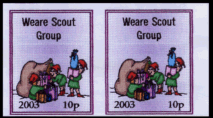
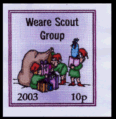
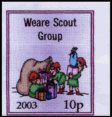
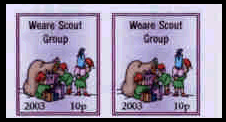
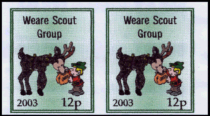

Types 40a to 40f and 41a to 41c, designed and produced by ? on sheets of 21 (7 rows of 3) square-cornered self-adhesive labels (produced by Neat Ideas) with 2 stamps per label on rows 1, 2, 3, 5, 6 & 7. All sheets were guillotined across row 4 before issue to give smaller sheets of 18 stamps each. There are several small differences in the sizes of the images - in each pair the left hand one is 28mm wide while the right hand one is 30mm wide. Heights can also vary - for the 10p there are 33, 34 & 35mm high versions, for the 12p only 33 & 35mm versions exist. Type 40d has oversized digits in the price. The sizes of the images above are as follows :-
40a 28mmx35mm, 40b 30mmx35mm, 40c 30mmx33mm, 40d 30mmx35mm, 40e 28mmx34mm, 40f 30mmx34mm.
41a 28mmx35mm, 41b 30mmx35mm, 41c 30mmx33mm.
These are arranged on the sheet as follows :-
10p efefef 12p ababab
efefed ababab
ebabaf ababab
ababab ababab
ababab ababab
ababac ababac
2004
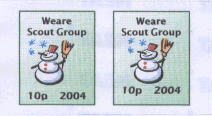

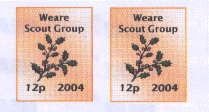
Types 42a to 42c and 43 (pair), designed and produced by ? on sheets of 21 (7 rows of 3) square-cornered self-adhesive labels (produced by Neat Ideas) with 2 stamps per label on rows 1, 2, 3, 5, 6 & 7. All sheets were guillotined across row 4 before issue to give smaller sheets of 18 stamps each. There are several small differences in the 10p images - in each pair the left hand one has value and date placed lower than the one on the right. There is a constant error (an extra star) on stamp three of row 2 - see 42c. The 12p has no significant variations.
2005
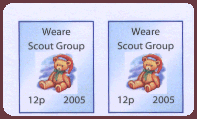
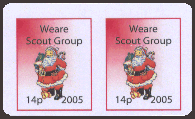
Types 44 to 45, designed and produced by ? on sheets of 21 (7 rows of 3) square-cornered self-adhesive labels (produced by Neat Ideas) with 2 stamps per label on rows 1, 2, 3, 5, 6 & 7. All sheets were guillotined across row 4 before issue to give smaller sheets of 18 stamps each. For once there was only one significant variation - the following "missing 2" variety - last stamp in bottom row.

Cancellations
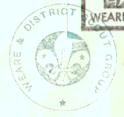
Type P1 - used with a single line datestamp on ordinary mail and FDCs in 1981.
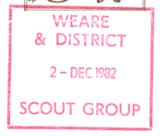
Type P2 - used on ordinary mail and FDCs from 1982 to 1984.

Type P3 - used on ordinary mail and FDCs from 1985, 1986, 1987, 1989, 1997, 2000, 2001 & 2002.

Type P4 - used on ordinary mail and FDCs in 1988, 1990, 1994, 1996 & 1999.

Type P5 - used on ordinary mail and FDCs in 1991, 1992, 1995 & 1998.

Type C1 - used on FDCs in 1989.

Type C2 - used on FDCs in 1990 & 2001.
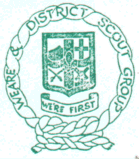
Type C3 - used on FDCs from 1991 to 2000.
Statistics
| Year | 1981 | 1982 | 1983 | 1984 | 1985 | 1986 | 1987 | 1988 | 1989 | 1990 |
| Start | Dec 3 | Dec 2 | Dec 2 | Dec 1 | Dec 2 | Dec 4 | Dec 5 | Dec 3 | Dec 4 | Dec 1 |
| Carried | 562 | 831 | 916 | 1,390 | 437 | 1,011 | 1,009 | 878 | 1,036 | 839 |
| Year | 1991 | 1992 | 1993 | 1994 | 1995 | 1996 | 1997 | 1998 | 1999 | 2000 |
| Start | Dec 1 | Dec 1 | None | Dec 1 | Dec 1 | Dec 1 | Dec 1 | Dec 1 | Dec 1 | Dec 1 |
| Carried | 866 | 723 | None | 572 | 585 | 644 | 786 | 667 | 585 | 714 |
| Year | 2001 | 2002 | 2003 | 2004 | 2005 | 2006 | 2007 | 2008 | 2009 | 2010 |
| Start | Dec 1 | Dec 1 | Dec 1 | Dec 1 | Dec 1 | None | None | None | None | None |
| Carried | . | . | . | . | . | None | None | None | None | None |
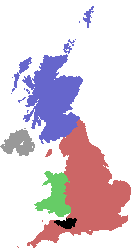
Return to Somerset Index
Return to Alphabetic Index - W
Return to Scout County of Somerset Index
This page last amended 1st March 2021
© copyright 2021 John Crabbe